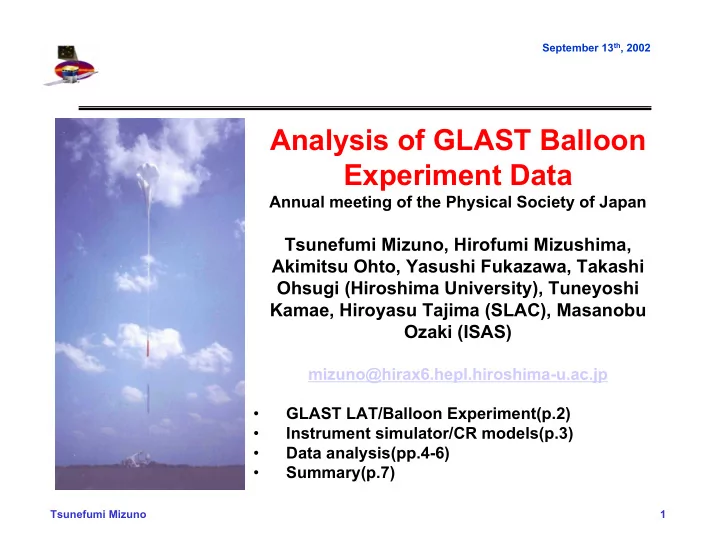

September 13 th , 2002 Analysis of GLAST Balloon Experiment Data Annual meeting of the Physical Society of Japan Tsunefumi Mizuno, Hirofumi Mizushima, Akimitsu Ohto, Yasushi Fukazawa, Takashi Ohsugi (Hiroshima University), Tuneyoshi Kamae, Hiroyasu Tajima (SLAC), Masanobu Ozaki (ISAS) mizuno@hirax6.hepl.hiroshima-u.ac.jp • GLAST LAT/Balloon Experiment(p.2) • Instrument simulator/CR models(p.3) • Data analysis(pp.4-6) • Summary(p.7) Tsunefumi Mizuno 1
September 13 th , 2002 GLAST Large Area Telescope/Balloon Experiment GLAST Large Area Telescope/Balloon Experiment Balloon Flight Engineering Model GLAST LAT(20MeV-300GeV) (BFEM): single tower 4X4=16tower eXternal Gamma-ray Target(XGT) Anti Coincidence Detector (ACD) Si-Strip Tracker (TKR) CsI Calorimeter Support (CAL) Structure • To achieve high sensitivity aimed by • During the level flight (@38km), we GLAST, we need to estimate collected cosmic-ray events (>=100k) to background in orbit accurately. be used for a background database for LAT. Tsunefumi Mizuno 2
September 13 th , 2002 Instrument simulator and Cosmic- -ray models ray models Instrument simulator and Cosmic Proton energy spectrum (from zenith) A Geant4-based Monte-Carlo instrument simulator BESS (magnetic north pole) XGT AMS ACD our model (used in Geant4 Simulation) TKR CAL primary with geomagnetic secondary cutoff and solar modulation (atmospheric) @ Palestine, 2001 0.01 0.1 1 10 100 GeV Support Pressure alpha Structure Vessel electron/positron •particles with underline are expected in orbit atmospheric gamma muon Tsunefumi Mizuno 3
September 13 th , 2002 Count Rate of Each Layer for “ “Charged Events Charged Events” ” Count Rate of Each Layer for Count rate of each layer for • trigger rate (Data) “Charged Events” (hit in ACD) ~445Hz Real Data • simulation total (level flight) (our prediction muon before the flight) gamma ~350Hz e-/e+ proton : 145Hz alpha alpha : 18Hz e- : 45Hz proton e+ : 30Hz gamma : 50Hz muon : 62Hz Count rate observed and 26 Si layers simulation prediction (13 planes: x-y pair) agree with each other in CAL ~20% ACD TKR Tsunefumi Mizuno 4
September 13 th , 2002 Angular distribution of “ “Charged Events Charged Events” ” Angular distribution of (preliminary) (preliminary) Zenith angles of the Straightness of the straight/single track reconstructed track Data Data Simulation (total) muon muon gamma e-/e+ proton alpha alpha e-/e+ gamma proton 10 -6 10 -3 1 10 3 rms (arbitrary unit) horizontal downward cos (theta) straight track • Data and simulation agree with each other in ~20%. • We may need to increase the proton/alpha/muon flux to explain data. Tsunefumi Mizuno 5
September 13 th , 2002 Count Rate of Each Layer for Neutral Events Count Rate of Each Layer for Neutral Events Count rate of each • trigger rate (Data) layer (no hit in ACD) ~55Hz • simulation total muon (our prediction thick Lead converters before the flight) ~52Hz gamma Real Data proton : 3.1Hz (level flight) alpha : ~0Hz e- : 6.9Hz e-/e+ e+ : 3.9Hz proton gamma : 35.5Hz muon : 2.4Hz • Overall agreement is good between data and prediction. • Count rate in upper layers are smaller than data. Tsunefumi Mizuno 6
September 13 th , 2002 Summary Summary • We performed GLAST Balloon Experiment on August 4 th , 2001. • All detector components worked well in high-counting enviroment. • We obtained ~100k Cosmic-ray events to be used as a background database for LAT. • We have developed a Geant4 based instrument simulator and Cosmic-ray flux models. • We have investigated the count rate, straightness of the track and angular dependence of the flux. • Data and simulation prediction agree with each other in ~20%, below uncertainty of CR flux. • Detailed study is underway. Tsunefumi Mizuno 7
Recommend
More recommend